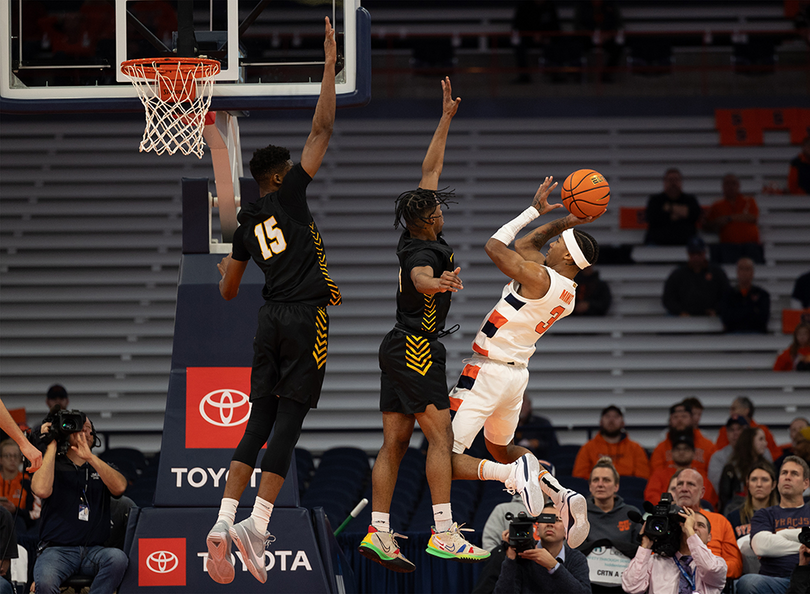SU’s static half-court offense limits chances for statement win

For most of this season, directionless offensive sets have been the bane of SU’s success. Ryan Jermyn | Staff Photographer
Get the latest Syracuse news delivered right to your inbox. Subscribe to our sports newsletter here.
After North Carolina’s 103-67 win over Syracuse on Jan. 13, head coach Hubert Davis said the Orange primarily score in two areas. He gameplanned for both.
“Their top two (are) off of steals and then getting to the free throw line,” Davis said.
SU’s reliance on creating offense in transition and off of turnovers prompted Davis to hone in on “protecting the basketball.” He justified the focus by saying that Syracuse ranks first in the conference with 9.56 steals per game. Then, as if looking for further corroboration, Davis referred to the box score in front of him.
“In the first half, I think (Syracuse) scored 30 points, 19 of them were off of free throws and off of (North Carolina) turnovers,” Davis said. “So, that’s something going into the game that we identified and something we had to do well.”
Their preparation panned out flawlessly. The Tar Heels held the Orange to just nine fast break points, seven steals and 18 points off of turnovers — eliminating the visitors’ preferred, pacy brand of play. Unable to find holes in North Carolina’s transition defense, Syracuse’s half-court offense remained stagnant.
But this isn’t anything new. Since SU’s nonconference slate, it’s struggled to generate consistent offense in the half-court. Rushed heaves early in the shot clock and its sparse perimeter passing has led to contested looks. Though Syracuse’s dependence on fast break opportunities and frequenting the charity stripe have culminated in a few impressive victories, its stubborn offense is easily dissectable. And unless the Orange find consistency in the half-court against set defenses, conference losses could pile up.

Cindy Zhang | Digital Design Director
The first glimpses of a now-prevalent mid-season issue emerged at the Allstate Maui Invitational (Nov. 20-22). In SU’s opening contest, it jumped out to an encouraging start against then-No. 7 Tennessee. Within the first few minutes, Chris Bell caught fire, later finishing with a team-high 16 points. J.J. Starling converted on a few nifty moves inside and Benny Williams tacked on an efficient eight.
Yet, for the ensuing 10:36 before halftime, SU’s offense fell flat. The Volunteers went on a commanding 19-6 run. Despite trailing 24-21 at the 2:47 mark in the opening half, they entered the second with a 30-25 cushion.
And for the rest of the game, Syracuse never scored at a consistent clip — a plague which continued in a 76-57 defeat to then-No.11 Gonzaga.
Facing the Bulldogs, SU attempted 24 3-pointers but made just three. It continued to attempt difficult jumpers early in the shot clock. Judah Mintz recorded a game-high 22 points though, as a team, the Orange mustered a lowly 35.9% from the floor.
Syracuse displayed flashes versus Tennessee and Gonzaga. Yet, it lacked continuity in its offensive sets, registering just 15 combined assists in the two contests. At times, SU guards drove and dished for high-percentage looks inside or wide-open 3s — shots head coach Adrian Autry wants.
But one of the core contributors to the Orange’s 0-2 start in Honolulu, Hawaii, was a series of empty trips down the floor filled with errant shot selection and minimal ball movement. It’s a problem which has regularly reared its head in 20-plus point losses to Virginia, Duke and North Carolina.
In its first Atlantic Coast Conference outing at John Paul Jones Arena on Dec. 2, 2023, Syracuse looked fortunate to trail Virginia 37-24 at the break. Defensive lapses persisted — the likely culprit behind an increasing deficit — but the Orange never looked comfortable in their half-court offense. A plethora of isolation possessions from Mintz resulted in ineffective pump fakes and airballs. Careless passing around the perimeter translated into run outs for the Cavaliers.
More of the same came at Duke on Jan. 2. Though the Orange stayed within five across the first few minutes after halftime, things quickly unraveled. A double-digit Blue Devils lead materialized, stemming from SU turnovers in the half-court. Bell left his feet deep in the paint with nowhere to go. Starling coughed up possession on a similar move penetrating the right wing. Quadir Copeland drove head down before spiraling out of control at the left elbow.
“That’s something we’ve been working on especially from last year,” Justin Taylor said of SU’s spacing after its loss to Duke. “I think that’s a big change for us.”
Whatever Autry drew up was blown up. A few select pick-and-rolls between Copeland and Maliq Brown snuck through. Not much else worked. Was the execution poor? Or was Duke an uber-talented defensive side? Either way, Syracuse was rendered helpless.
When comparing SU’s marquee victories to its sizable defeats, a stark difference presents itself. Syracuse thrives in transition. It relishes visits to the free throw line. It’s a frustrating combination for the opposition, yet one that can easily be picked apart. UNC was the latest side to expose the Orange’s limited offensive arsenal, with SU poaching seven steals to create just nine fast break points.
But there’s been improvement as of late. In Syracuse’s bounce-back 69-58 win at Pittsburgh, its second victory over the Panthers this season, SU totaled 10 3s at a 58.8% mark. Signs of multi-dimensional scoring surfaced. There was success in the half-court. Mintz and others didn’t have to force straight-line drives into traffic. Handoffs, kickouts and cross-court feeds developed into a steady double-digit SU advantage for most of Tuesday’s matchup.
“I thought we had some offensive poise today,” Autry said postgame. “We had good spacing. The ball moved. I mean, we had seven different guys make 3’s. That hasn’t happened all year.”
So where does Syracuse go from here?
Its most recent victory at the Petersen Events Center showed effective half-court sets. But the Orange’s prior repetitions of stagnant offensive possessions — one that still has them devoid of a Quad 1 win as of Wednesday morning — should trigger doubt around this team’s scoring capabilities.
With consecutive home showdowns against Miami, FSU and NC State to see out January, resume-building wins are up for grabs. But to do so, Syracuse must command the half-court as it did versus Pitt. Touches given to all five players while looking for the best option are crucial and SU needs to take controlled looks instead of hurried, off-balance jumpers.
Otherwise, Syracuse looks like it could fall short of an NCAA Tournament berth for the third consecutive season.





